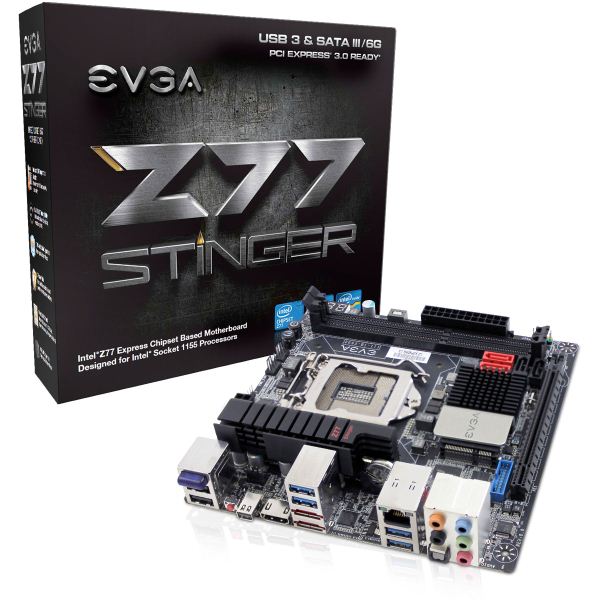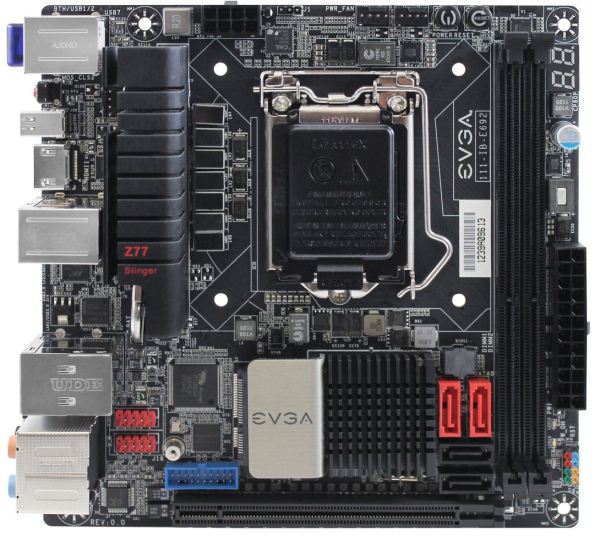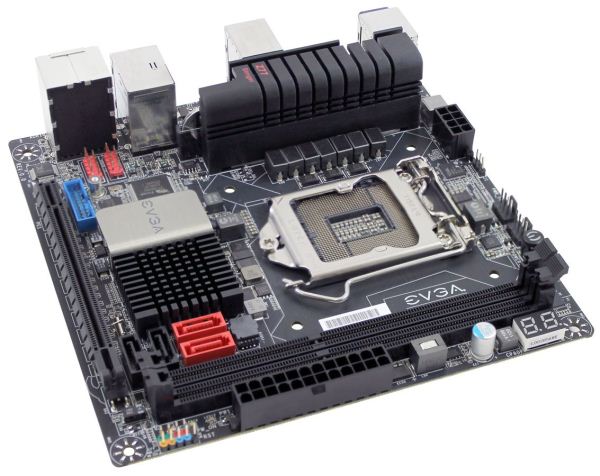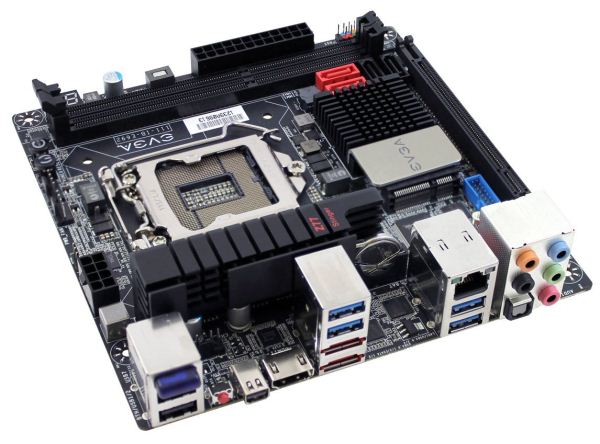Z77 mITX Round-Up: Five of the Best – MSI, Zotac, ASRock, EVGA and ASUS
by Ian Cutress on December 31, 2012 7:00 AM EST- Posted in
- Motherboards
- MSI
- ASRock
- EVGA
- ZOTAC
- Asus
- Ivy Bridge
- Z77
- mITX
EVGA Z77 Stinger Overview
For the fourth motherboard of this review, the design philosophy of the Z77 mITX board takes a turn on its head – almost literally. We find the socket moved to the top, and the chipset placed underneath. This ultimately gives more freedom when it comes to placing CPU coolers, albeit the EVGA Z77 Stinger is still limited in one dimension due to the close proximity of the memory slots. Users can happily place a longer cooler in the other direction though.
As a price of $200, it certainly raises the asking cost for a mITX board to new heights. A good number of great ATX sized motherboards are already at this price, including a few we have awarded. This instantly makes the EVGA a tougher sell, but in order for a little compensation, EVGA get heavy handed with some of the features.
We get an Intel NIC on board unlike the other mITX so far, but on the downside it is coupled with the Realtek ALC889 which failed our 192 kHz testing. We get a mini-PCIe slot, though with no WiFi module like with some of the other boards. EVGA have decided to up the total USB 3.0 count to six with an ASMedia controller powering the onboard header as well as upping the SATA 6 Gbps count with a Marvell controller powering the two eSATA 6 Gbps on the rear IO. The EVGA is also one of few boards to have the power/reset button combination with a debug LED that changes to a CPU temperature monitor after POST. If anything the rear IO looks a little sparse, with HDMI and mini-DisplayPort being the only options for video output. It looks like some of the connectivity had to be lost in order to fit a couple of the controllers on board.
EVGA are still not completely on the bandwagon with a graphical and interactive BIOS, showcasing a white text on black scenario. To make matters worse, XMP is not properly implemented in the first BIOS release, and returning to optimized defaults changes everything back to normal except the BCLK. On the software side, the driver install is a one-by-one affair which requires user interaction despite the fact that these driver installs when sent to EVGA offer silent install modes. The only software we get is EVGA E-LEET which allows the user to adjust the overclocks and priority of programs on the fly – it is for all intents and purposes an advanced version of CPU-Z. Fan control is not in the software – that is solely for the BIOS.
Performance of the EVGA is on par with the other motherboards tested – nothing comes out as overly great or bad. This makes a $200 mITX a tough sell – it has the socket position I prefer and an Intel NIC, but the support behind the motherboard in terms of the BIOS or Software pale in comparison to the cheaper models. One upside of purchasing an EVGA board is that all RMA requests are direct with EVGA rather than the supplier, which may add to that additional cost as well.
Visual Inspection
As noted in the overview, the main comparison with the previous motherboards and the EVGA is the location of the socket area. Here the socket is above the chipset, which changes a lot to do with port location. Our 8-pin CPU power connector is now at the top edge of the board with a pair of four-pin fan headers. As the chipset is underneath the socket, so are the USB 2.0 and USB 3.0 headers and the SATA ports. The result is a mixed bag, with USB cables having to stretch over components in order to fit into the board.
Unlike most of the other mITX boards, we get three fan headers – two located to the top right of the socket (both 4-pin) and another on the rear IO side of the power delivery heatsink (also 4-pin). The socket area still caters in the left-right direction to the Intel minimum specifications, meaning that coolers that conform to at least one of the dimensions should be placed such that any full sized memory does not interfere.
With the chipset below the socket, our SATA ports are in the bottom right area between the memory slots and the PCIe device. The orientation of the SATA ports is going to give issues if any need to be taken out, requiring most of them to be removed each time. To the left of the chipset is a mini-PCIe (not mSATA) port for a WiFi/WiDi module, which is not included in the package – this is in contrast to the other mITX motherboards tested which do have one.
Along the top right of the motherboard are a pair of power/reset buttons which I always find useful in testing. To the right of these is a two-digit debug LED, also useful for diagnosing issues. This two-digit debug LED turns into a CPU temperature readout after POST, which is an awesome feature to have. Unlike some other mITX builds, the Front Panel connector is found at the bottom right of the motherboard in an ideal location for most orientations.
The rear IO panel is a little different to the previous motherboards tested. Normally the rear IO is fighting for space to fit in all the different connectors wanted on the product, but EVGA have decided to cut some of the fluff and stick to components they think most of their users will want to use. From left to right we have a BlueTooth module, two USB 2.0 ports, a Clear_CMOS button, a mini-DisplayPort, HDMI, four USB 3.0, two eSATA 6 Gbps, an Intel NIC, and audio jacks from the Realtek ALC889.
Board Features
| EVGA Z77 Stinger | |
| Price | Link |
| Size | Mini ITX |
| CPU Interface | LGA-1155 |
| Chipset | Intel Z77 |
| Memory Slots |
Two DDR3 DIMM slots supporting up to 16 GB Up to Dual Channel, 1066-2133 MHz |
| Video Outputs |
HDMI mDP |
| Onboard LAN | Intel 82574L |
| Onboard Audio | Realtek ALC889 |
| Expansion Slots |
1 x PCIe 3.0 x16 1 x mPCIe |
| Onboard SATA/RAID |
2 x SATA 6 Gbps (Chipset) RAID 0, 1, 5, 10, 0+1 2 x eSATA 6 Gbps (Marvell) RAID 0, 1, 5, 10, 0+1 2 x SATA 3 Gbps (Chipset) RAID 0, 1 |
| USB |
4 x USB 3.0 (Chipset) [4 back panel] 2 x USB 3.0 (ASMedia ASM1042) [2 onboard] 6 x USB 2.0 (Chipset) [2 back panel, 4 onboard] |
| Onboard |
2 x SATA 6 Gbps 2 x SATA 3 Gbps 1 x USB 3.0 Header 2 x USB 2.0 Headers 1 x Front Panel Header 3 x Fan Headers Power/Reset Buttons Debug LED |
| Power Connectors |
1 x 24-pin ATX Power Connector 1 x 8-pin CPU Power Connector |
| Fan Headers |
1 x CPU (4-pin) 2 x PWR (4-pin) |
| IO Panel |
1 x Bluetooth Module 2 x USB 2.0 1 x Clear_CMOS Button 1 x mDP 1 x HDMI 4 x USB 3.0 2 x eSATA 6 Gbps 1 x Intel NIC Optical SPDIF Output Audio Jacks |
| Warranty Period | 3 Years |
| Product Page | Link |
For the large $200 price tag for the Z77 Stinger, the lack of a WiFi module on board is a little disappointing, as well as the use of the Realtek ALC889 rather than anything higher up the Realtek order catalogue. On the plus side we do get an Intel NIC, an additional USB 3.0 controller, an additional SATA 6 Gbps controller (for eSATA ports) and, in my opinion, a better oriented mITX motherboard. Also that third fan header is one more than most mITX motherboards.














54 Comments
View All Comments
IanCutress - Monday, December 31, 2012 - link
Gigabyte wanted their H77 reviewed instead, which we reviewed recently: http://www.anandtech.com/show/6427Athelstan - Monday, December 31, 2012 - link
Thanks for the review. I'm curious why you mention the audio chip on all of these board. For the intended purpose, wouldn't the audio be over HDMI, making the onboard audio unused in most cases? Even then, all of the boards have optical out, making the audio chip to have very little to do other than to pass along the bitstream from the media thought the optical connection.IanCutress - Monday, December 31, 2012 - link
The audio chip also controls the front panel audio, and even if the audio was going through the HDMI, external speakers for a HTPC may be used via the audio jacks. In my personal usage scenario, my video out is via DVI-D to a 2560x1440 Korean panel via a dGPU, meaning all my audio still goes through the normal audio jacks. The other reason is that if I did not mention it, someone in the comments would ask why wasn't the audio chip mentioned. There is a price difference between the ALC889, ALC892 and ALC898, though manufacturers obviously get these on bulk deals (or at a discount when bought with the Realtek 8111E/F) and I am not privy to that information.Ian
Taft12 - Monday, December 31, 2012 - link
Speaking of audio, could you let us know the differences between those 3 Realtek audio chipsets? Is there any sound quality difference, or is it only features?mczak - Monday, December 31, 2012 - link
The 892 has somewhat crappy ADC/DACs quality-wise (that said most likely signal routing etc. on the board will have a much bigger effect on sound quality than the quality of the DACs, so using a higher quality chip can still easily result in worse quality than using a cheap chip with more care taken). The 889 and 898 seem quite similar there on paper.I think just about the only thing you'd really miss is the dolby digital live / dts connect features (encode multichannel audio to digital if you're using the digital outputs). But these are pure software features, so you can get them with the 892 as well - I believe though the board manufacturers are more likely to license them with the more expensive chips (I don't know if you could "upgrade" your chip with unofficial means there...). Realtek actually seems to list different ordering numbers depending on these features - interestingly there while all 3 of these chips are listed as a version without any of DDL/DTS Connect, only the 889 has a version with both of them, while the 892 only has a version with DTS Connect, and the 898 only has the version without them - the datasheet still lists those features as optional however.so maybe they just stopped using different ordering numbers (the 889 clearly is the oldest of the 3).
Athelstan - Monday, December 31, 2012 - link
*grins* Good point. If you don't mention it someone else would be asking for it.Stacey Melissa - Monday, December 31, 2012 - link
I'm running the ASUS board, and installed the AI Suite for a different ASUS Z77 board in order to get access to Fan Expert 2, which has far better fan control than v.1. Wish I could remember which Z77 board it was, but all I did was check the download pages for various Z77 boards to find one that included AI Suite with Fan Expert 2.IanCutress - Monday, December 31, 2012 - link
MSI include a program as part of the package to update the software, making sure you have the latest available. ASUS and Gigabyte need to do this ASAP, so people can take advantage of things like Fan Expert 2 without having to visit the website. System integrators often just install the drivers and software on the CD when selling a system, and then the user never updates it unless told to by either (a) friends or (b) the software itself.Ian
mfenn - Monday, December 31, 2012 - link
Am I the only one who is getting tired of the liberal copy-pasting of content between motherboard (and SSD) reviews on this site? I don't need to waste my time reading about the MSI design competition in every single review.I understand the need to provide background information to readers who may not peruse every single review, but that's why Tim invented the hyperlink. Link to the old review or to a purpose-built "company profile" page.
Sabresiberian - Tuesday, January 1, 2013 - link
Adding info some may be familiar with is preferable to leaving it out. If you don't want to read it, then I suggest you just skim or skip it entirely. :)